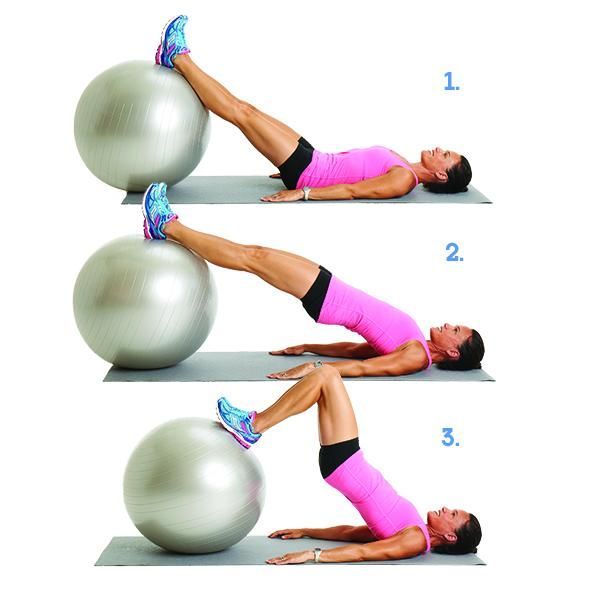15 de July de 2025
Stability Ball Hamstring Curl: Exercise Guide, Tips and Benefits
The stability ball hamstring curl is a highly effective lower-body exercise that challenges your hamstrings, glutes, and core—without the need for machines. Using a stability ball adds a balance component, forcing your muscles to work harder to control each repetition. This makes it a favorite among athletes, rehab professionals, and anyone looking to enhance posterior chain strength and joint stability.
What Is a Stability Ball Hamstring Curl?
This exercise involves lying on your back with your feet on a stability ball and curling the ball toward your body by bending your knees, then extending your legs to the starting position. It mimics the leg curl machine but incorporates more core activation and balance.
It’s a go-to move in functional training and rehabilitation because it encourages joint-friendly, multi-muscle engagement that improves control and mobility.
How to Do a Stability Ball Hamstring Curl
- Setup: Lie on your back with your heels placed on top of a stability ball. Arms are flat on the floor for support.
- Bridge Position: Lift your hips off the ground so your body forms a straight line from shoulders to heels.
- Curl In: Bend your knees and pull the ball toward your glutes using your hamstrings. Keep your hips elevated.
- Extend: Slowly straighten your legs, rolling the ball back to the starting position.
- Repeat: Perform 2–4 sets of 10–15 reps with control.

Benefits of Stability Ball Hamstring Curls
- Hamstring Strength and Endurance: This movement isolates the hamstrings while integrating them into a functional, compound motion. It helps improve both strength and muscular control, essential for athletic performance and injury prevention.
- Glute Activation: Holding your hips up during the curl engages the glutes isometrically, helping reinforce hip stability.
- Core Stability: The unstable nature of the ball requires constant core engagement, especially during the concentric (curl) phase. This improves your ability to stabilize your spine during athletic movements.
- Joint-Friendly: Unlike some machine exercises, this variation limits compressive forces on the knees and back, making it suitable for those in rehab or with mobility issues.
- Improves Balance and Coordination: It challenges neuromuscular control by forcing your body to stabilize during each repetition—especially as fatigue sets in.
- Great for Fatigue Management: It’s an effective low-load option to include in a fatigue-conscious training plan.
- Complements Strength Programs: Integrates easily into any posterior chain-focused strength and conditioning program. Learn how to structure these in our strength and conditioning guide.
Common Mistakes to Avoid
- Dropping the Hips: Letting your hips sag during the curl reduces glute engagement and puts unnecessary strain on your lower back. Keep your hips level throughout the movement.
- Using Momentum: Swinging or bouncing the ball diminishes the effectiveness of the exercise. Perform each rep slowly and under control.
- Not Engaging the Core: Without a tight core, you’ll lose balance quickly. Brace your abs from the start.
- Partial Range of Motion: Failing to fully extend or curl your legs limits muscle engagement. Aim for a complete range with each rep.
- Improper Ball Size: Using a ball that’s too large or small can compromise alignment. Choose a ball size that allows you to keep your body in a straight line during the bridge position.
- Overextending the Knees: Fully locking out your knees at the bottom may strain the joint. Keep a slight bend in the knees when extending.
- Incorrect Foot Positioning: Feet too far apart can shift focus away from the hamstrings and compromise balance. Keep them hip-width or slightly narrower.
Variations to Try
- Single-Leg Hamstring Curl: Increases the challenge and addresses muscular imbalances.
- Glute Bridge Hold + Curl: Pause at the top of each curl to intensify the glute engagement.
- Elevated Shoulders: Perform the curl with your upper back on a bench for a deeper stretch and contraction.
How to Program It in Your Routine
Add it to a leg day, core circuit, or as part of your posterior chain accessory work. It’s particularly useful in high-volume training blocks, recovery phases, or as part of injury-prevention strategies. Aim for 2–3 sets, 1–3 times per week.

FAQs About Stability Ball Hamstring Curls
Are stability ball hamstring curls good?
Yes. They’re excellent for building hamstring and glute strength while also improving core stability and coordination.
What size stability ball for hamstring curls?
Generally, a 55–65 cm ball suits most users. Your hips should form a straight bridge line when your feet are placed on the ball.
How to do a stability ball hamstring curl?
Lie on your back with feet on the ball, lift your hips, and curl the ball toward you using your hamstrings, then extend back with control.
Which hamstring curl is best?
While machine curls isolate the muscle well, stability ball curls offer functional benefits and core engagement that many traditional options lack.
Is stability ball worth it?
Yes. It’s a low-cost, highly versatile tool for improving balance, strength, and coordination, especially for home workouts.
The stability ball hamstring curl is more than just a leg exercise—it’s a total posterior chain activator that helps improve coordination, reduce injury risk, and build foundational strength. Incorporate it into your training to complement heavier compound lifts and maintain joint health.
